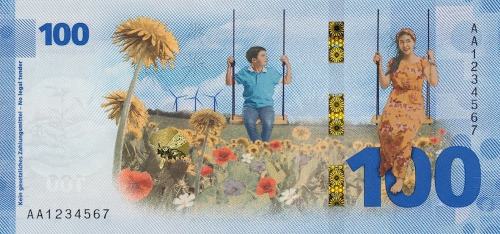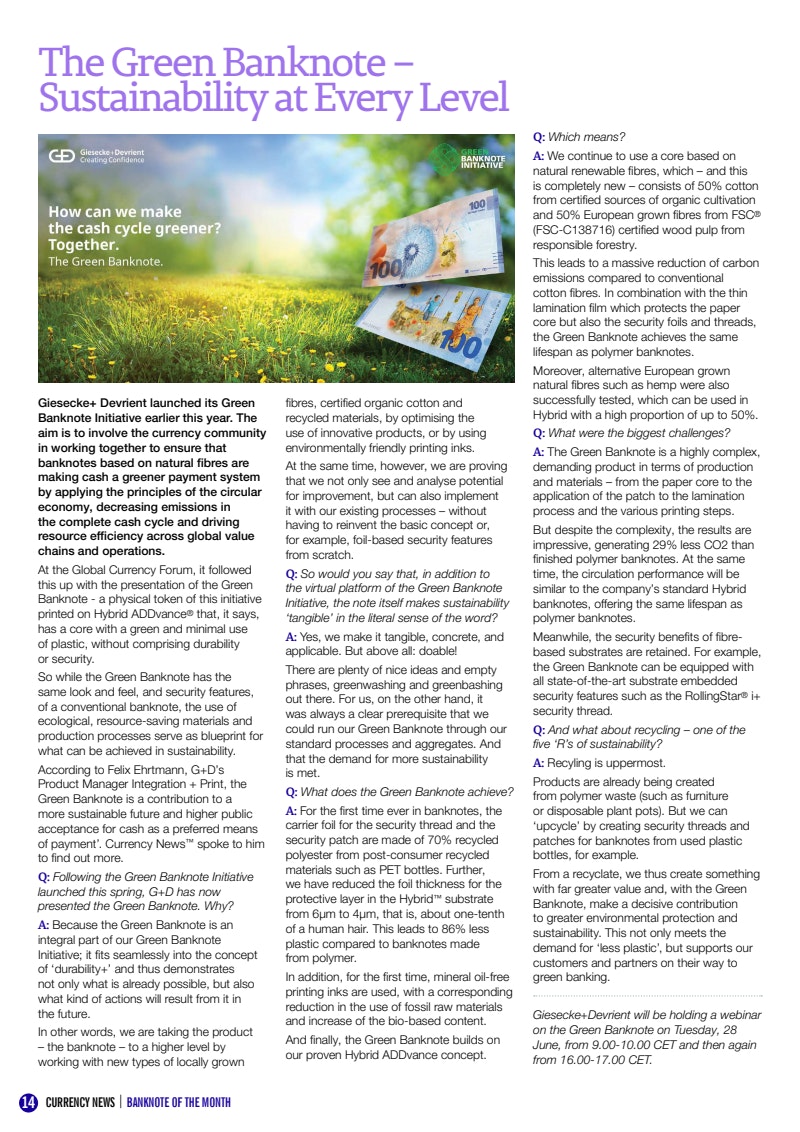Product Owner : G+D and Louisenthal
Project Team
Date the Program was first implemented
Project Description
The “Green Banknote” is a sustainable product solution for banknotes. It reduces the ecological footprint of a banknote by using certified natural fibres, optimizing the use of plastics sparingly and an efficient production process, thus making a real contribution to climate protection. With the Green Banknote Initiative, It points the way to a future banknote that is as sustainable as it is secure. The initiative demonstrates that there are ways to achieve durability and security in a sustainable way.
The key driver of banknote sustainability is durability. The longer banknotes remain in the cash cycle, the less frequently they have to be replaced. With the Hybrid substrate, the durability of banknotes is relatively high, whereas the core in the Green Banknote is still made out of natural fibers. With this high renewable content, the carbon footprint can be even more reduced by different fibers. For instance, almost no pesticides and fertilizers are used for the cultivation of organic cotton, which has a positive impact on the carbon footprint. This is also recognized by leading central banks, for example the ECB.
At the same time, all non-renewable components are tried to keep at a very low share of the whole banknote, e.g. the thickness of polymer film could be reduced from 6µm to 4µm, the carrier foil for security threads and security patches were made out of 70% recycled plastic and it was the very first time, that mineral oil free inks are used for the simultan printing of a banknote.
Countr(ies) where implemented
The Green Banknote has been released in 2022, and enthusiastically endorsed around the world. Two countries have placed orders of two denominations for delivery in 2023.
Innovative, unique, and/or inventive aspects of the project
There are several innovative/unique attributes:
- The core of the banknote paper is an emission-minimizing fiber mix of organic cotton and FSC®
(FSC-C138716) certified cellulose, which comes from European forestry. The material mix reduces carbon
emissions by 63% compared to fibers made from conventionally grown cotton. - The Green Banknote uses 86% less plastic than polymer banknotes. The carrier film for the RollingStar® i+
security thread and the varifeye® ColourChange security patch comes from a certified recycling circuit with 70% recycled polyester. This transforms recycled plastic waste into a high-quality security feature. - For greater durability, it is laminated with a thinner PET film, representing a reduction
of 38% plastic compared to the standard Hybrid™ substrate. Significantly, it has the same lifetime as polymer banknotes.For the first time, certain inks based on mineral oils are replaced by vegetable oils
in the simultan printing of the banknotes.Environmental sustainability challenge/problem
The currency industry is striving to act on its responsibilities for the environment and the sustainable development of the economy. The banknote industry must reduce its carbon footprint and contribute to sustainability. As a key measure, G+D has developed the “Green Banknote”. It has been developed off the back of findings from a study by G+D subsidiary Louisenthal, which calculated the product-related carbon and water footprint of various substrates in the entire cash cycle.
The Green Banknote required an intensive sustainability review of all components from the paper core, to the composition and manufacture of the security features, and the material composition of inks for print.
With the ability to use bio cotton from different labels (e.g. Cotton mad in Africa), also social sustainability aspects are addressed. Such labels support fair working conditions of the farmers as well as fair salary.Level of Expected/Proven impact on Environment
The key findings were that cotton-based banknotes have the smallest CO2 footprint among available banknotes. Hybrid™ notes, as the leading product in terms of sustainability, generate up to 22% less CO2 during their lifetime and up to 38% less CO2 during production than plastic banknotes.
The Green Banknote contributes to environmental sustainability by the reduction of carbon emissions of 23% compared to the conventional Hybrid™ note, only resulting from exchanging certain components by more sustainable ones. Additionally, it generates up to 38% less CO2 during production than plastic banknotes.
This can be seen as relatively high, especially while still providing the same durability. The reduced carbon footprint was measured by first calculating the footprint of the normal Hybrid Banknote (100% conventional cotton, polymer layer of 6 μm, 100% virgin material for security patch and thread, mineral oil containing inks) and then calculating the carbon footprint of the Green Banknote, with the exchanged components. The size and equipment with security features was set equally to get a valid comparison. All data come from the same database which makes the comparison possible.Please see table of comparison of Green Banknote to Hybrid
Organization’s commitment to environmental sustainability
G+D puts sustainability at the centre of its operations. In 2010, G+D joined the United Nations Global Compact. The Group-wide corporate goal is to make the entire value chain sustainable in the long term, and to continuously reduce its ecological footprint, especially on environmental, social, and governance (ESG) platforms. And Louisenthal´s sustainability project won IACA`s Best New Environmental Sustainability Project in 2020, and last year it launched the Green Banknote Initiative. It is committed to becoming net zero and to generate 75% of revenue from green products by 2040.
Two examples already demonstrate this:- At Louisenthal`s two large banknote paper mills, we already treat 40% and 58% of the water, respectively, and feed it back into circulation.
- The Solar Project G+D Malaysia is actively reducing the CO2 footprint of the plant by 34.000t / year. The generated power is directly consumed by the plant, saving approx. 2.2MWh/a.
-




